Here is a low-carb sweet and spicy Szechuan noodles made with zucchini noodles, aka zoodles. Check how to make zucchini noodles at home with a julienne peeler and how to make this Szechuan noodles with the same.
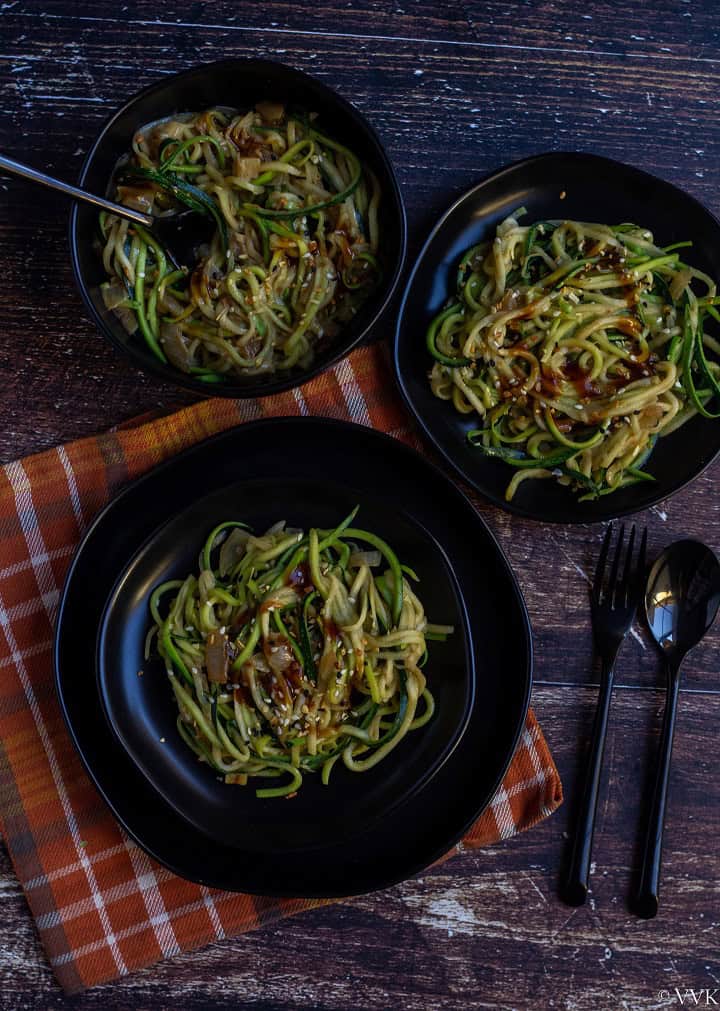
When life throws zucchini at you, you make anything and everything with zucchini. :-) If there is one vegetable that you can grow easily in the backyard, it must be zucchini. Every year, I harvest a decent amount of zucchini, and it’s the same this year as well. If you are following me on Instagram, you would have seen my harvest and the zucchini transplantation stories. I have started a new gardening series on my IGTV and do check it out.
Jump to:
Now back to the cooking business. Nothing can beat the joy of cooking with the fresh produce. I have posted quite a few Indian recipes with zucchini like pakora, rice, raita, soup etc. And this year, I wanted to try something different, and I am starting with this zoodles.
Why homemade zoodles-
Zoodles is the fancy name for zucchini noodles. You can find packed zucchini noodles in stores easily these days. It’s super convenient to grab a pack from the store, but guess what, making it at home is super easy folks. It’s fresh and cheap as well. Like cauliflower rice, you can easily make it at home.
You don’t need special equipment like a spiralizer for making this zoodles. Well, if you have one already, it’s great. But let me tell you this: You can make zucchini noodles easily with a julienne peeler—there is no need to own any special equipment.
Using julienne peeler to make zucchini noodles-
Most of us will have a julienne peeler at home; that’s what you need for this zoodles as well. All you have to do is trim the edges of the zucchini. Then hold the peeler against one side of the zucchini and run across length-wise to create strands/strips. Keep rotating the vegetable after two to three peels.
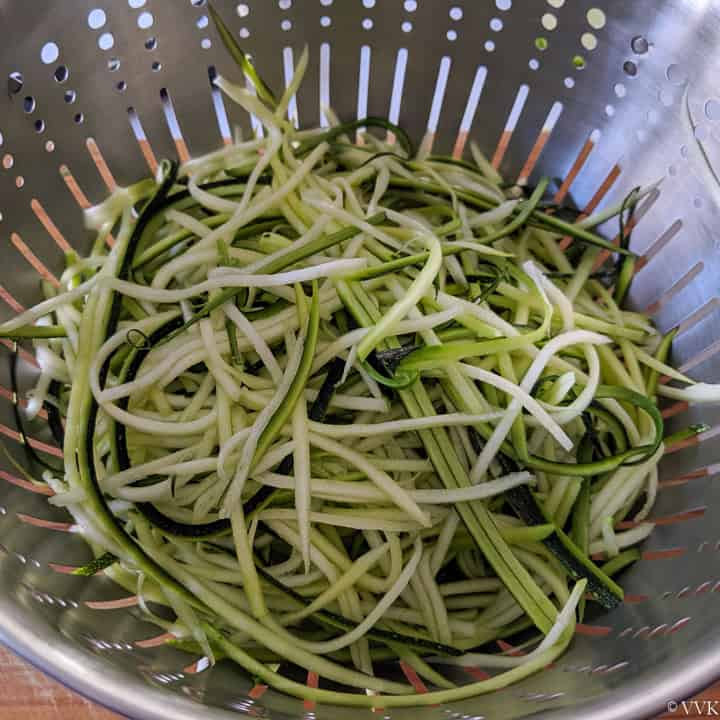
Let me tell you the pros and cons of this method-
Pros-
- Julienne peeler is cheap and doesn’t consume a lot of space. Easy to buy and easy to use.
- It makes thin noodles, and I like it.
Cons-
- It’s hard to peel as you reach the middle of the vegetable. That’s why I said keep rotating the vegetable after two to three peels, but even then, a big chunk of vegetables will be left out. But you can very well use it for soups, dal and veggie pasta. No wastage, but you will not be able to make zoodles fully.
- It’s not time-consuming, but there is a manual work of peeling, unlike the spiralizers.
As I haven’t used any other way of making zoodles, I can’t compare, so let me stop here.
Shelf-life of zoodles-
You can make zoodles well ahead, and I haven’t stored it beyond two days. But if you make a dish with zoodles, try to consume it right away. Storing it might not work. With salt and other condiments, zucchini continues to release water, and the dish will become soggy. So make the zoodles ahead and mix the sauce just before serving.
Low carb noodles/pasta-
Zoodles are great alternatives to pasta and noodles. With types of equipment like spiralizers, mandoline peelers, and julienne peelers, you can make zucchini spaghetti, flat pasta like pappardelle, etc. These zucchini noodles are gluten-free and low-carb. These natural vegetable-based noodles/pasta are your best bet if you follow a keto or low-carb diet.
Sweet & spicy Szechuan noodles/zoodles-
Now that I have shared about zoodles, let me share the sauce that I made for this. Zoodles are more like pasta or noodles, and you can use any basic sauce that you would use for your pasta/noodles.
I made it more like my udon noodles with a spicy sauce and balanced it with a nut-butter. I used Szechuan sauce that I bought from whole-foods and used almond butter and regular onion and garlic.
This recipe is a basic version, and you can jazz it up the way you want with more veggies and protein of your choice.
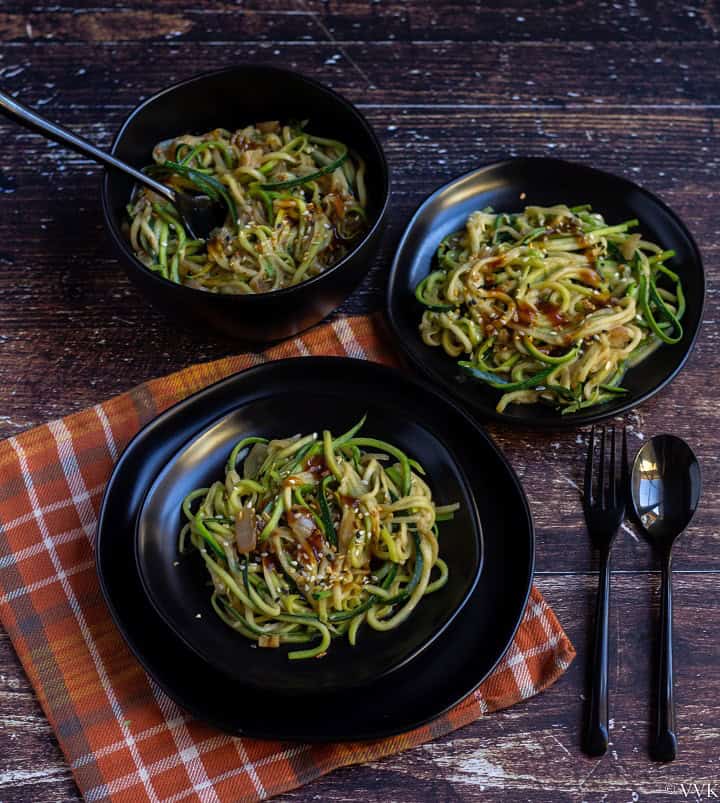
Serve it with a plant-based protein like tofu for a completely vegan meal.
Ok, as always I wrote a lot. Let’s get straight into the recipe without any further ado.
How to make zucchini noodles-
- Trim the edges of the zucchini and hold it tight. Then hold the peeler against one side of the zucchini and run across length-wise to create strands/strips. Keep rotating the vegetable after two to three peels. This method leaves a big chunk of the core; you can use it for soups, dal, and other recipes.
- I used one massive(yes, a massive one) zucchini from my backyard, and after peeling, I got about 550 grams of zucchini noodles.
Blanching the zucchini- (Optional step)
- I blanched the zucchini just for one minute in hot water. But if you like raw zucchini, you can ignore this step.
- I am insisting this, again, and again, do not blanch the zucchini for more than one minute. It will become soggy if you blanch for more than a minute.
- Bring 8 to 10 cups of water to boil until you see the bubbles—no need to bring it to a rolling boil and add salt as well.
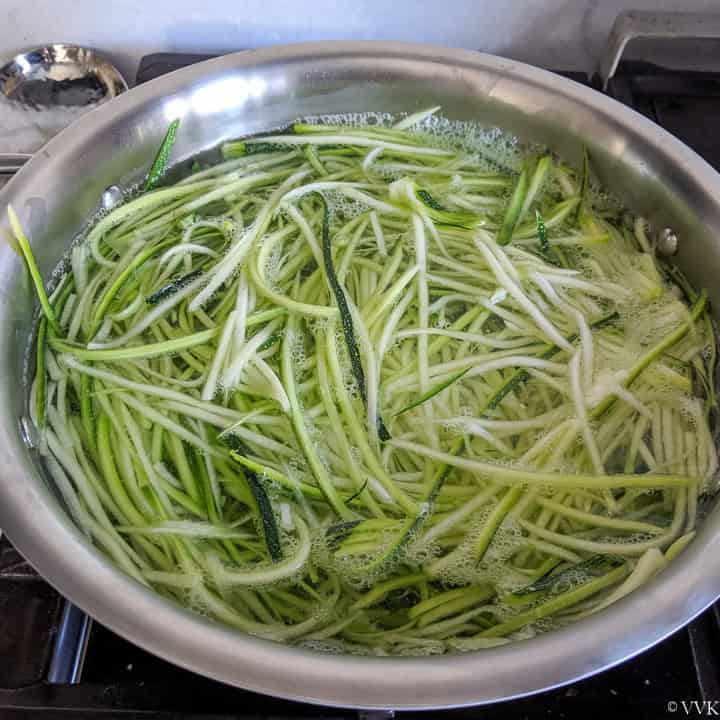
- Turn off the heat and add the zucchini into the water. Make sure you have immersed the zucchini well inside the water—there is no need to cover it and let it sit in the water for one minute only.
- Immediately drain the water and run it through cold water and let it sit.
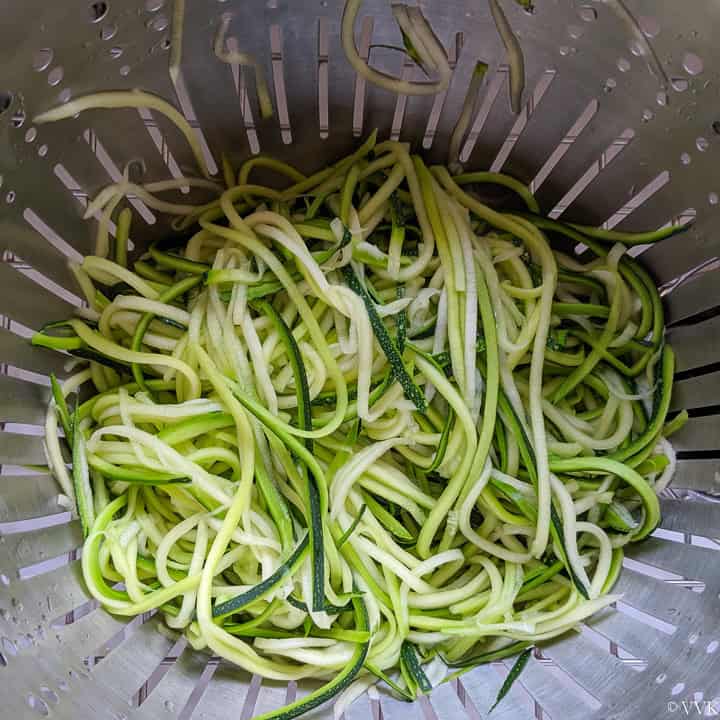
Preparing the sauce-
- In a wok or kadai, heat 1 tbsp of oil.
- Add the sesame seeds and roast for 20 to 30 seconds. Then add the chopped onion and garlic and saute until the onion turns soft.
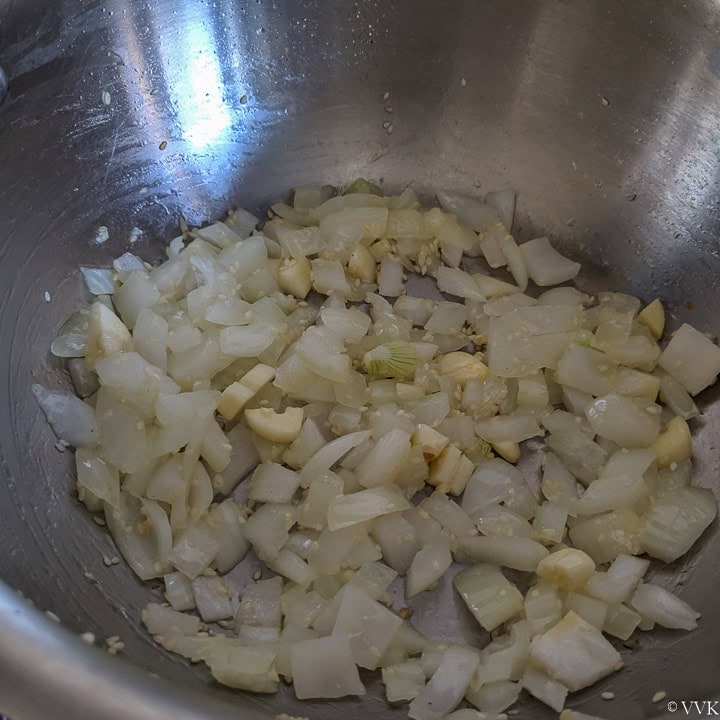
- Now add the soy sauce, Szechuan sauce, almond butter, salt, and sugar.
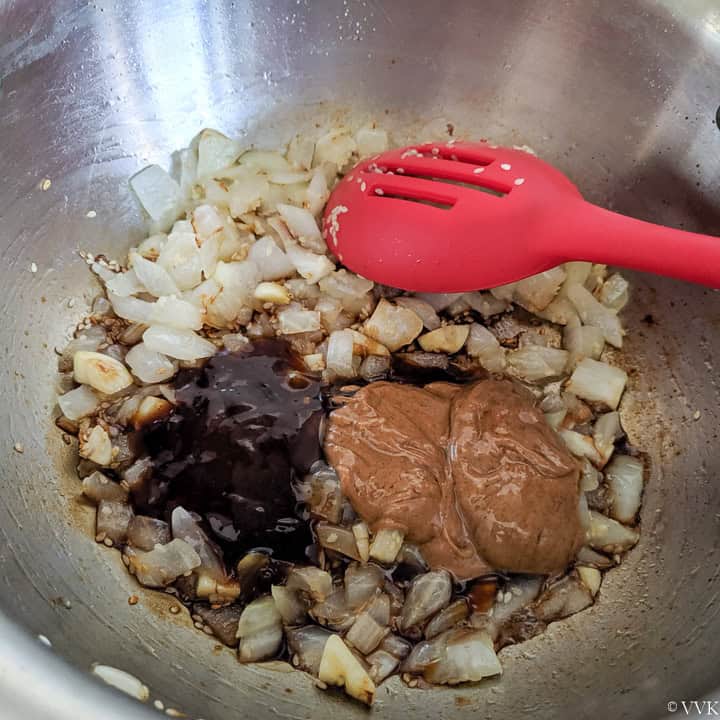
- Mix thoroughly and turn off the heat.
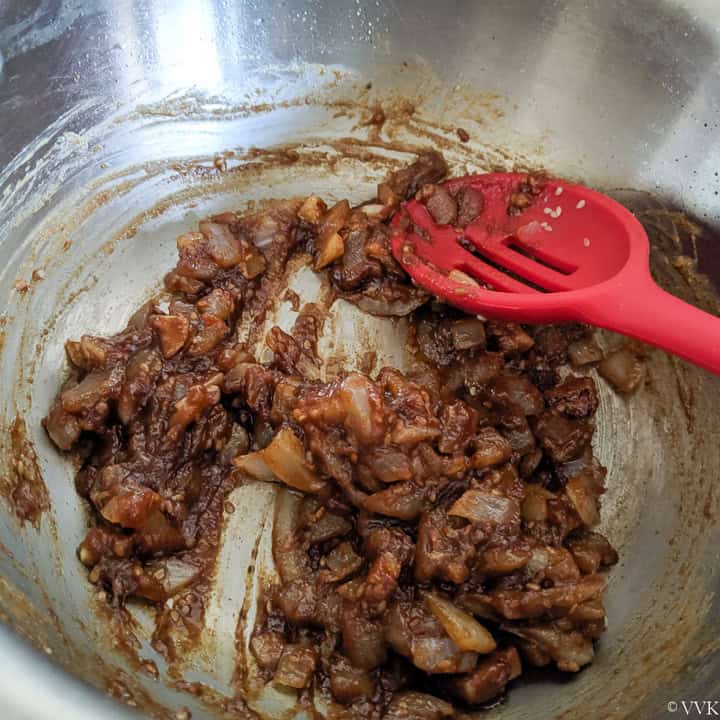
Mix the sauce and zoodles and serve-
- Now add the blanched zoodles and gently mix.
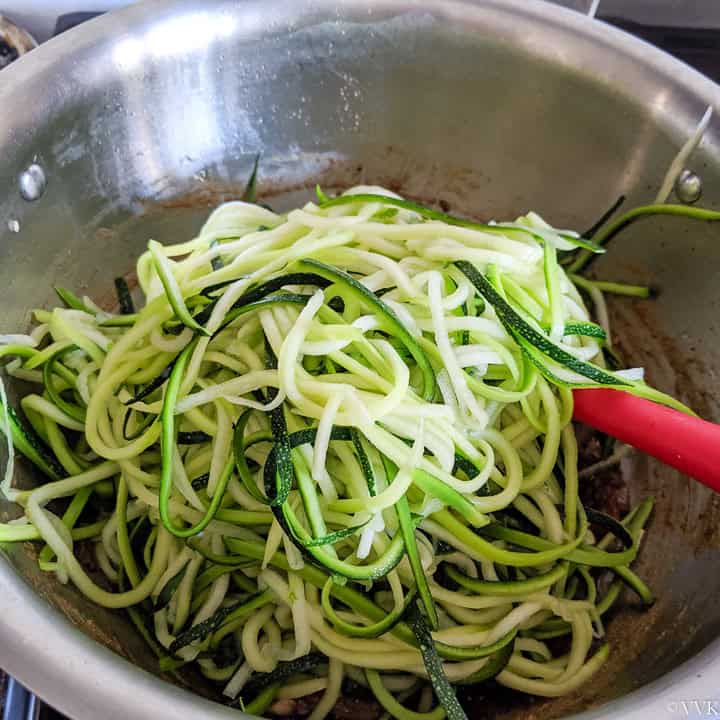
- Do not overmix, and no need to cook zoodles again. Zucchini will ooze out water, but it won’t become mushy. Even if you skip the blanching process, with time, zucchini will ooze out water. So serve right away.
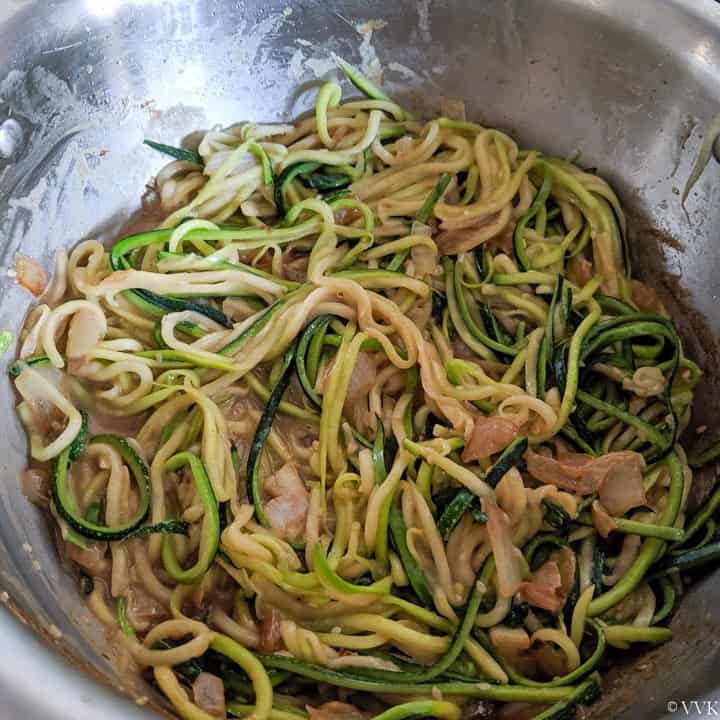
- The oozed out water will serve as a sauce. But do not store it for a long time.
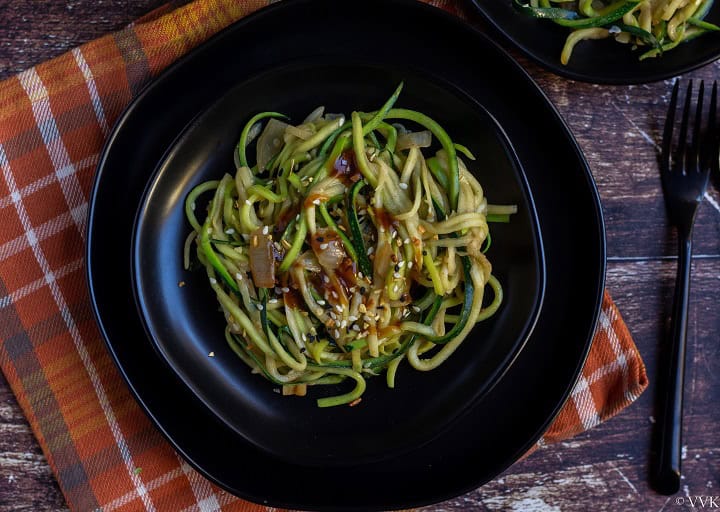
Recipe Notes-
- Blanching is optional, and if you are blanching, do not blanch for more than a minute.
- Also, after preparing the sauce, toss and mix the zoodles just before serving. Do not cook the zoodles again.
- Adjust the sauces according to your preference. Reduce the Szechuan sauce amount for a not-so-spicy zoodles.
- Instead of almond butter, you can use any nut butter of your choice. Peanut butter equally works well in this recipe.
- If you have roasted sesame seeds, you can drizzle after preparing the zoodles instead of roasting them in the beginning.
- Add a handful of roasted and crushed peanuts for crunchy noodles.
- The sauce I made is very basic with available ingredients at home. You can always mix and match different sauces and come up with your concoction.
- Make sure you use a gluten-free sauce if you are intolerant to gluten.
If you like this Szechuan zoodles, you will also like,
PS: Follow me on Instagram or join my Facebook Group for more gardening and recipe updates. If you try this zoodles recipe, please don’t forget to comment and rate this recipe. If you have any questions, please leave a comment, and I will get to it asap. Make sure to follow me on my Pinterest for more healthy and delicious ideas!
📖 Recipe
Sweet and Spicy Szechuan Zucchini Noodles | Szechwan Zoodles
Equipment
- wok or kadai
- julienne peeler
Ingredients
Instructions
How to make zucchini noodles-
- Trim the edges of the zucchini and hold it tight. Then hold the peeler against one side of the zucchini and run across length-wise to create strands/strips. Keep rotating the vegetable after two to three peels. This method leaves a big chunk of the core; you can use it for soups, dal, and other recipes.
- I used one massive(yes, a massive one) zucchini from my backyard, and after peeling, I got about 550 grams of zucchini noodles.
Blanching the zucchini- (Optional step)
- I blanched the zucchini just for one minute in hot water. But if you like raw zucchini, you can ignore this step.
- I am insisting this, again, and again, do not blanch the zucchini for more than one minute. It will become soggy if you blanch for more than a minute.
- Bring 8 to 10 cups of water to boil until you see the bubbles—no need to bring it to a rolling boil and add salt as well.
- Turn off the heat and add the zucchini into the water. Make sure you have immersed the zucchini well inside the water—there is no need to cover it and let it sit in the water for one minute only.
- Immediately drain the water and run it through cold water and let it sit.
Prepare the sauce-
- In a wok or kadai, heat 1 tbsp of oil.
- Add the sesame seeds and roast for 20 to 30 seconds. Then add the chopped onion and garlic and saute until the onion turns soft.
- Now add the soy sauce, Szechuan sauce, almond butter, salt, and sugar.
- Mix thoroughly and turn off the heat.
Mix the sauce and zoodles and serve-
- Now add the blanched zoodles and gently mix. Do not overmix, and no need to cook zoodles again. Zucchini will ooze out water, but it won't become mushy. Even if you skip the blanching process, with time, zucchini will ooze out water. So serve right away.
- The oozed out water will serve as a sauce. But do not store it for a long time.
Notes
- Blanching is optional, and if you are blanching, do not blanch for more than a minute.
- Also, after preparing the sauce, toss and mix the zoodles just before serving. Do not cook the zoodles again.
- Adjust the sauces according to your preference. Reduce the Szechuan sauce amount for a not-so-spicy zoodles.
- Instead of almond butter, you can use any nut butter of your choice. Peanut butter equally works well in this recipe.
- If you have roasted sesame seeds, you can drizzle after preparing the zoodles instead of roasting them in the beginning.
- Add a handful of roasted and crushed peanuts for crunchy noodles.
- The sauce I made is very basic with available ingredients at home. You can always mix and match different sauces and come up with your concoction.
- Make sure you use a gluten-free sauce if you are intolerant to gluten.
Nutrition
I am not a nutritionist. The nutritional information is provided as a courtesy and is an estimate only. It varies depending upon the product types or brands.


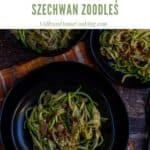
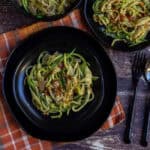

Looks good ? I bought zucchini noodles, will try it soon.
Thanks. :-)